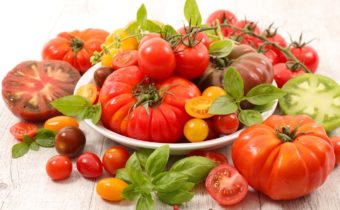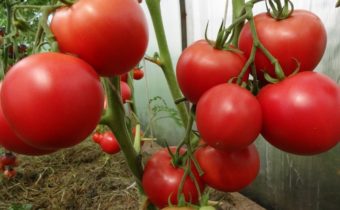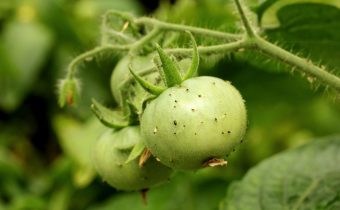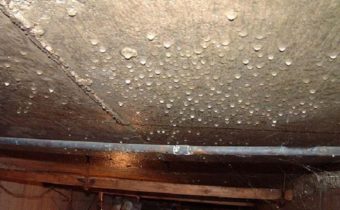Close the greenhouse for the winter: step by step instructions
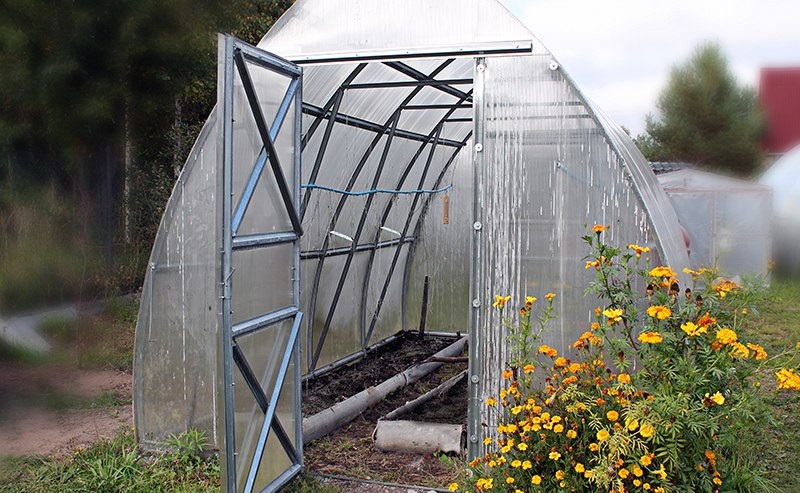
Experienced summer residents advise starting greenhouses for the next season immediately after the harvest of the current year. The list of necessary autumn works depends on the type and condition of the structure, crops, for the cultivation of which the shelter is intended, diseases or pests appearing on plantings in the current season.
Why prepare a greenhouse for the winter?
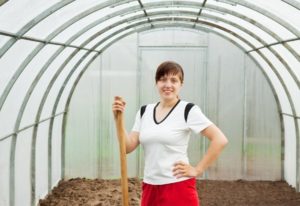
Even if the shelter is not used in winter, the main work must be carried out in the autumn, ending before the onset of cold weather, for three reasons:
- The microclimate in a greenhouse - heat and increased air humidity, are favorable conditions for the reproduction of many harmful microorganisms, primarily fungi. After each cycle of growing vegetables, it is recommended to clean and disinfect the soil and structure. The timeliness of sanitary procedures increases the chances that the pathogenic microflora that survived after them will die as a result of winter frosts.
- Plants deplete the soil, especially if the greenhouse has been used for growing the same crop for several years. Therefore, before the next planting, it is necessary to reduce the soil indicators to those required by plants for normal development and fruiting. In the autumn it is convenient to plant fertilizers that are long processed, such as manure and green manure.
- Over time, the frame of the greenhouse and elements of fasteners wear out, so the building should be inspected and, if necessary, undertaken, to repair, to replace parts, painting. In the spring, there may be no time for these procedures; in addition, under the influence of precipitation and low temperatures in winter, the state of the structure will deteriorate.
How to remove a greenhouse after growing tomatoes
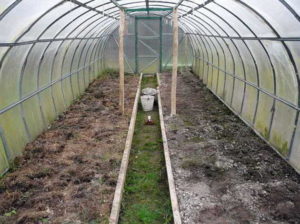
If in the current season tomato beds have not been attacked by fungi or pests, it is necessary to carry out routine cleaning and preparation of the greenhouse for the next season. In this case, the following works are recommended.
- harvesting plant residues;
- restoration of soil quality;
- greenhouse construction cleaning.
If pests or diseases were noted on the tomato bushes in the greenhouse, careful disinfection of the soil and structures is necessary.
Harvesting tops
After harvesting, it is necessary to harvest and remove all plant residues from the greenhouse - tomato tops, remaining fruits, weeds. The biomaterial is recommended to be burned, even if the plants are outwardly healthy: a slight insect damage, like the appearance of diseases in the late stages of the growing season, can pass unnoticed by the gardener. It is on the leaves and stems of plants, including weeds, that most often remain spores of fungi, viruses, eggs of pests (but some species go to the soil). Mild wintering in greenhouses increases the likelihood of their return next season.
Before burning the tops of tomatoes should be dried in the sun, otherwise it will burn badly. The remaining ash from plants as fertilizer is not inferior to wood ash, in addition, it can be used to dust the bushes in the fight against pests.
From the top layer of soil you need to choose the rhizomes of plants. To do this, the soil should be dug to a depth of 5-7 cm using forks. The order should be brought not only inside but also outside the greenhouse, clearing the space around the structure from weeds and remnants of annual crops.
Improving soil for growing tomatoes
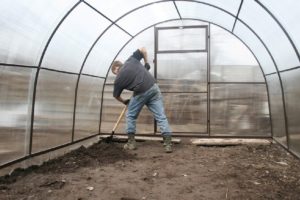
After growing tomatoes it is necessary to restore soil fertility. To do this, organic fertilizers are buried in the ground or a layer of green manure is put. A mixture of fresh manure, peat, compost and humus will be suitable as an organic top dressing. This mass should be introduced in a volume of from 5 to 12 kg per 1 m2, depending on the exhaustion of the soil.
Mustard, lupine or legumes are recommended as siderats for tomatoes. This method is suitable if the greenhouse is intended for growing varieties of early ripening and is released by the end of July or mid-August, since the plants must have time to grow by autumn. After siderata increase the green mass, they need to be cut at the level of the root and spread out on the surface of the soil with a layer of 5-10 cm.
After adding organic matter or a green manure layer, the soil should be watered with biopreparations with effective microorganisms (Vostok, Baikal, Shining and others). As a result of their vital activity, the microflora contained in these products will not only enrich the soil with humus by spring, increasing its quality, but also destroy harmful bacteria and fungi in it. Watering with EM preparations is especially important if fresh manure has been introduced into the soil, since pathogenic microflora is actively developing in it. To prepare the solution, you need to dilute 150 ml of the drug in a bucket of water. It is necessary to irrigate the land at the rate of 3-5 liters of solution per 1m2.
Once every 2-3 years, depending on the characteristics of the soil, it may be necessary to bring its indicators to the standards required for tomatoes, that is, alkalization or acidification procedures, application of baking powder, etc.
Optimal soil parameters for tomatoes:
| soil parameter | optimum indicators for tomatoes |
| structure | loose |
| type of | loamy or sandy |
| acidity level | pH 6.0-6.8 |
| fertility rate | average (4%) |
| content of nitrogen, phosphorus, potassium | 350 ml per liter (of each element) |
| groundwater level | deeper than 1 m from the surface |
If it is not possible to remove the shelter for the winter, after the snow falls, it is recommended to scatter it in a greenhouse with a layer of 25-30 cm. In spring, the thawed snow will saturate the soil with oxygen.
Construction processing
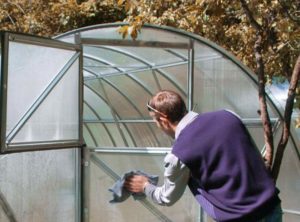
Before cleaning, the greenhouse should be disassembled (if the construction permits it), since some parts of the framework cannot be processed qualitatively when assembled. It is necessary to wash all the parts of the greenhouse - cover, frame, fasteners.
Structures made of plastic, polycarbonate, metal and glass, as well as film, should be washed with soapy water. For preventive disinfection of strong soap solution (a bar of laundry soap on a bucket of water) will be enough. When cleaning you need to consider the requirements of the material:
- Polycarbonate surfaces must not be cleaned with hard brushes or burlap rags. For washing you need to use sponges, rags made of soft fabrics.
- The film coating is never left for the winter, otherwise it will become unusable. The film should be rolled up, previously washed out and dried, and put away for storage.
- The metal frame after washing should be thoroughly wiped with a dry cloth and re-painted.
- The wooden frame is recommended to be whitened with quicklime.
With the onset of frost is recommended to open all the vents and doors in the greenhouse. This will reduce the load of snow on the roof and prevent the formation of ice on the walls of the shelter, which causes a temperature difference.
Disinfection after pests and diseases
In the event that diseases or parasites appear on landing in the greenhouse, to prevent relapse in the next season, it is necessary to disinfect the shelter.When choosing a greenhouse processing method, you need to take into account the materials from which the frame and transparent surfaces of the structure are made.
Metal carcass
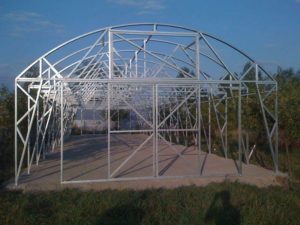
In contrast to the wooden and PVC construction, the aluminum profile of the greenhouse can be subjected to heat treatment - pour boiling water. The procedure is carried out after removing the film coating or polycarbonate panels from the frame.
For disinfection of metal construction is allowed to use 9% vinegar, diluted with 20 parts of water. It is more efficient to add it to boiling water. Metal parts having a lacquer coating may be treated with 1% bordeaux liquid.
PVC pipe frame
An effective treatment for PVC frames will be bleach solution:
- Dissolve 400 g of bleach in a bucket of water.
- Let it brew for 4 hours, stirring occasionally.
- After the last stirring, leave for 15 minutes.
- Drain the upper transparent layer, trying not to touch the "thick".
- The remaining mass must be processed frame.
To disinfect the soil, you can use the drained top layer of the liquid (solution of low concentration).
For disinfection of plastic frames, you can use a solution of vinegar of the same concentration as for the treatment of metal products, but its temperature should not exceed + 60 ° C.
Wooden frame
Copper sulphate or Bordeaux liquid is best for processing wooden structures. The solution is prepared in a concentration of 7-10% and impregnated with wooden bars. To enhance the effect, the framework should be pre-wiped with bleach. After disinfection, the wood should be allowed to dry and whitewash fresh lime.
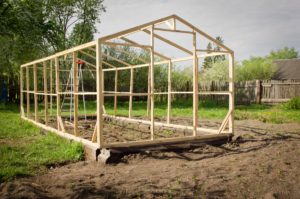
Since the tree may crack with time, and the processing of small cracks is difficult, the best way to disinfect the greenhouse will be fumigation with sulfur. This method is especially convenient for greenhouses that can not be disassembled.
Fumigation rules:
- Before the procedure, you need to carefully caulk all the cracks. For greater effect, you should moisten the inner surfaces of the greenhouse with water.
- Before the start of fumigation, care should be taken to protect hands (rubber gloves), eyes and respiratory organs (gas mask or respirator and goggles), since the substance releases compounds hazardous to human health during combustion.
- Sulfur or sulfur checker is used for fumigation. For every 10 m3, 1 kg of sulfur or 600 grams of sulfur checkers is required.
- The substance is crushed and mixed with coal.
- Metal pots or pans with the mixture are placed in pots with water (to reduce the potential fire hazard of the procedure) and evenly placed over the entire area of the shelter.
- After that, sulfur is ignited. The matter will slowly smolder, so it makes sense to open doors or vents in the greenhouse no earlier than after 5 days.
- After this period, the shelter should be thoroughly aired. In a greenhouse made of polycarbonate, after fumigation, the surfaces should be washed with soda solution.
Fumigation can also be carried out in a greenhouse with a PVC frame, but for metal structures, processing is allowed only if there is a special coating, as indicated by the manufacturer. The volatiles released by the burning of sulfur cause metal corrosion. Sulfur fumigation can be carried out in greenhouses made of polycarbonate, glass or film.
Experienced gardeners claim that the treatment of metal parts with solid oil before fumigation is able to protect the structure from damage.
Film, glass and polycarbonate
Glass, as well as polycarbonate panels, can be disinfected with bleach solution. Polycarbonate is also washed with a potassium permanganate solution. The film should be wiped with a solution of copper sulfate (4%) and left to dry, not rinsing. After this coating is removed for storage.
Auxiliary constructions
If a disease appears in the greenhouse, it is advisable to burn materials for tying up tomatoes and wooden supports.If it seems expensive or items made from materials that are difficult to destroy in this way (for example, metal or plastic pegs), it is necessary to soak them for half an hour in a solution of potassium permanganate or the preparation "Fitosporin." After soaking the product should be washed, dried and stored in a dry place.
Soil treatment after diseases and pests
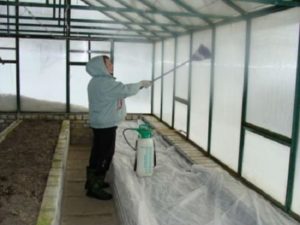
There are two approaches to the disposal of soil in the greenhouse from the pathogenic microflora and the larvae of harmful insects - disinfection and replacement of topsoil.
Soil treatment with chemicals is undesirable in a greenhouse, where harmful substances are less actively washed out by precipitation during the year, and the inability to apply crop rotation often forces one to undertake such treatments for several years in a row. The downside of the second method is its complexity.
Ground Disinfection
Soil processing chemicals can be carried out only in the fall. If you make it shortly before planting, the roots of tomatoes will absorb harmful substances from the soil, some of which will accumulate in the fruit.
If the tomatoes have undergone diseases, it is recommended to spray the soil with one of the following means:
- copper sulphate solution (10%);
- Bordeaux liquid (10%);
- solution of ferrous sulfate (2.5%);
- Fitosporin-M (only if the soil temperature is above 10 ° C).
To combat the insect larvae need to treat the soil:
- preparations "Trikhodermin", "Fitoverm", "Gaupsin";
- 4% bleach (in case of a spider mite, the concentration of the solution should be increased to 10%).
Replacing the soil
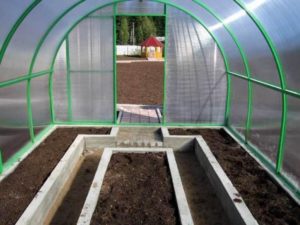
It is recommended to remove a layer of soil of about 15-20 cm, this will remove most of the hibernating spores of fungi, larvae of pests and bacteria. In addition, the main layer of weed roots and seeds is located at this level.
After removing the top layer of soil, in its place you need to put a mixture of peat, sand, rotted manure and compost. To it is useful to add wood ash, mowed grass, leaves. A new layer is dug up, mixing with the remained soil, after that mulch the earth in the greenhouse with straw.
If, after harvesting, dig holes in the ground, fill them with dry leaves or hay and cover them with soil, you can accelerate the heating of the soil in spring. The leaves will start to grind, warming up as a result of this process and raising the temperature of the nearest soil plots.
Proper implementation of all autumn work in the greenhouse will allow to receive fertile and clean soil from pests and fungi in the spring for growing tomatoes and other crops. Neglecting sanitary measures in the greenhouse is unacceptable, since in the case of many microorganisms and insect larvae even frost is not an obstacle to a successful wintering.



